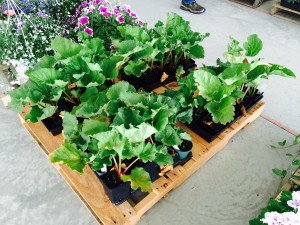Growing Rhubarb From Transplants; Not Roots
We have had a vegetable garden in six different states. In several gardens we have tried to establish rhubarb plants in our garden. We sourced plants through reputable mail order nurseries. All of our previous purchases of rhubarb plants have been in the form of root divisions.
Root divisions are made by taking the crown of a mature rhubarb plant and dividing it. This is usually done by a nursery after the plant goes dormant in the fall or early spring. The crown is cut in several pieces with a knife. When the crown is cut, the exposed root tissue is susceptible to being infected with disease organisms, usually a fungus. The nursery prevents infection in storage with fungicides and proper storage techniques including monitoring the temperature and humidity. When the root division is planted in a wet spring or the site has poor drainage, the chances of infection are increased. Most of the time we have been successful establishing our plants, but sometimes we have had difficulty with the plants dying, usually because they became diseased. The disease most likely did not come from the nursery but was exposed at our planting location.
This spring we planted rhubarb plants in a new location. We purchased established potted plants in a 4″ X 4″ pot. I did not remember seeing rhubarb plants offered for sale like this previously, but now I have seen them offered for sale at multiple outlets like Home Depot. The plants are not established from root cuttings, but are probably established by tissue culture. The obvious benefit of this type of plant offering is that there is no exposed open tissue that would be susceptible to infection. When we planted these plants, they established themselves quickly and grew very rapidly. They grew so rapidly that we were able to pick rhubarb eight weeks after planting.
The fruits of or labor!! We made a very delicious rhubarb pie. This is very simple to make. Use a home made or pre-made pie crust. Cut 4-5 cups of rhubarb stems (do not use the leaves); 4 cups for a normal pie pan and 5 cups for an extra large pie pan in 1/2 inch slices. Then mix 1 1/4 to 1 1/2 cups of sugar with 1/4 to 1/3 cup of flour. Spread the rhubarb slices in the bottom of the pie pan. Then pour the flour/sugar mixture over the top. Add about 5 butter pats to the top. Then use your top crust to cover the pie. You can use a lattice top or solid cover with vent holes. Bake at 400 degrees for about 50 minutes to an hour, or until you can see the sugar syrup bubbles coming up in the center.



